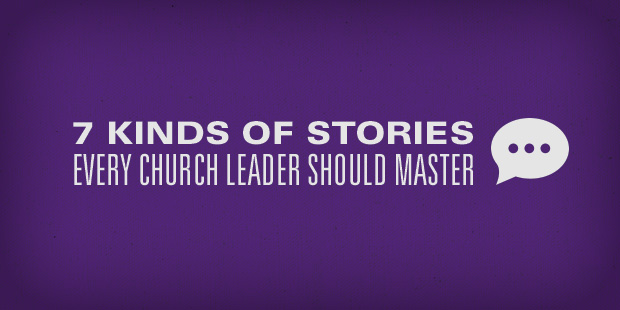
7 Kinds of Stories Every Church Leader Should Master
All ministry is communication intensive. It follows that story-telling and understanding the nuances of story will help any leader in the daily ebb and flow of communication. Use these story types to do an inventory on your own “range” of utilizing of stories as a leader.
CREATION STORY
I am not referring to the first book of Scripture but to the genesis of the organization itself. If you are a pastor, you should know more about the creation story of your church than anyone on the planet. What are the circumstances—passions, problems, and people—surrounding how the church got started to begin with? Mastering the richness of the creation story will help in two major ways. First, it will hold insight into the unique culture of the church and therefore future decision-making and vision. Second, your mastery of the story itself will bring tremendous credibility with people when initiating change.
>>ACTION STEP: Write a one-page, 2-minute creation story talk. If you have any gaps in your knowledge interview people in your church until you know more than anyone else.
SIGNATURE STORY
A signature story relates to any milestones or hand-of-God moments after the creation story. Obviously a church with more history will have more signature stories. These accounts show off strengths of the church and God’s hand in it’s history. I look for signature stories when discerning a church’s Kingdom Concept (What can your church do better than 10,000 others). These stories reveal the values and mark the high-water line of God’s activity and unique journey for each church. Use the signature stories the same way as the creation story: celebrating God’s goodness, explaining decision-making and guiding change.
>>ACTION STEP: Make a list of 3-5 possible signatures stories in your church. Ask key leaders to do the same and make a master list of the top 5.
FOLKLORE
Folklore stories are simply ones that are worth being told and retold. While there may be overlap between the first two of the list, folklore often focuses on the life change journey of individuals. Even though everyone has special stories of God’s transforming work in their lives, folklore shows off, in brilliant detail, the mission or strategy, a value or life mark, from the church’s articulated DNA (Vision Frame). Folklore often embeds a moment of modeling—like repeated prayer, gospel conversation or invitation toward an unchurched friend—that reflects “the win” we are striving for as a congregation. Imagine a church planter who sees a convert grow with unusual intentionality to become a key leader in the church. This story could model the pattern that we hope to see repeated over and over.
>>ACTION STEP: Identify 3 stories from individuals in your church that you know could never be shared too much. Ask another leader in your church to capture all of the details of the story in a 2-page, 5-minute summary.
HORIZON STORY
Now we turn our attention of story-telling to the future. Think of the horizon story as time-machine window where you tell people what God is going to do. It may have a lead in like, “What if…” or “Imagine…” Tell me a story of what the church will be like in one year. How about three years? When crafting this vision casting story, its important not to be presumptuous. To guard against that make sure you show what we call the “God smile,” that is, remind people that this is God’s idea not yours.
>>ACTION STEP: Prepare a 2-minute story to tell someone what your church will look like in one year. To give yourself freedom, don’t worry about sharing it with anyone— you may or may not. But practice thinking about the future feel of a story.
THE GOSPEL
The centerpiece of all story-telling is the Gospel. It is important to define every other story in relationship to the grand news of God’s intervention in our world and our lives through the death, burial and resurrection of Jesus. You may wonder, “This is a given, so why would you mention this as an organizational story.” First, I am surprised by how many congregations are stuck in a shallow appreciation for the Gospel’s ongoing presence and power in daily life. Second, as you master story as a leader, you won’t want to develop and practice the other story types to the neglect of the Gospel. Rather let the Gospel develop you as you integrate it into all story-telling.
>>ACTION STEP: Grab a copy of Center Church by Tim Keller and study the section on “Atonement Grammars.” This is one of the most helpful summaries I have ever seen.
TEACHABLE POINT OF VIEW
The last two kinds of stories have to do more with the personal life of the leader. A teachable point of view, a term coined by Noel Tichy in The Leadership Engine, is the story that surrounds a personal leadership learning. Informal leadership development happens best when an experienced leader, in relationship with other leaders can unpacks stories of why the do what they do. Where did this conviction come from? What led me to develop this skill? Why did I make what seemed to be a counter-intuitive decision? The more that you have thought about your leadership’s teachable point of views, the more often and intentional will be the transference of wisdom in your leadership culture.
>>ACTION STEP: Take 20 minutes and write down your top 10 learnings as a leader. Write down a few bullet points and begin to flesh out the story behind the learning.
CONVERSION STORY
The last story is the perhaps the most obvious, but I did not want it to go unstated. In my own leadership life, I have failed the most at rehearsing, in my leadership, the story of my own journey with God at its very beginning. Maybe that’s because it happened when I was in eighth grade. That seems pretty distant from the “important” leadership work of today. How many people on your leadership team know the details of how you trusted Jesus and how you grew in affection for the Gospel? Using your own conversation story as a leader is important for at least three reasons. First, it will keep you humble. Second, it’s a personal help to keep the Gospel at the center of all stories. Third, it will model for people the importance of sharing a personal testimony.
>>ACTION STEP: Create a one-page, 2-minute conversion story testimony. Practice sharing it with one person a week, asking the other person to share their conversion story.
Read more from Will here.

Tags: Folklore, Story, Will Mancini






















